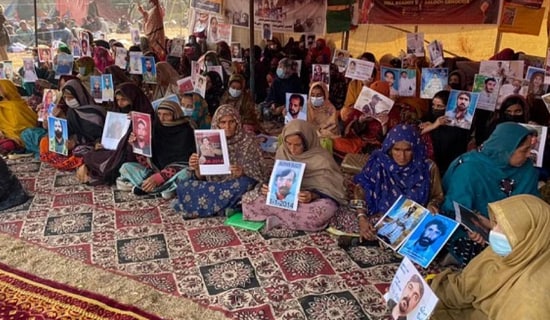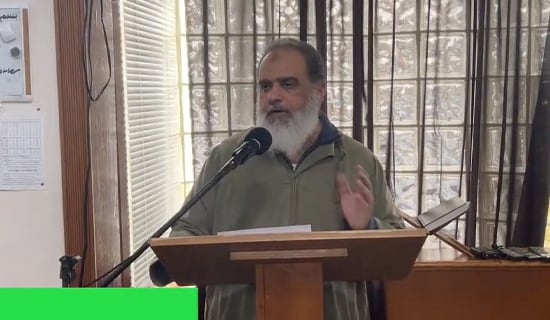Balochis are an ethnic group native to Balochistan, in Southwest Asia. In the last century, with the foundation of modern nation-states, their homeland was occupied and divided between Iran, Afghanistan, and Pakistan. There are no reliable statistics regarding the total number of Baloch people, though in 2013 their population was estimated at around 10 million.[1] Approximately, around 70 percent of the total Baloch population lives in Pakistan-controlled Balochistan, whereas 20 percent inhabits the southeastern Iranian province of Sistan and Baluchestan, and around 10 percent resides in the southern areas of Afghanistan.
Throughout the 20th century and up to today, Balochis have faced systematic discrimination, massacres, and forced resettlement. They have been deprived of their cultural, social, economic, and political rights in their own homeland.[2] After the foundation of the Islamic Republic in 1979, due to their adherence to Sunni Islam, the Balochis in Iran have become subjected to religious discrimination in addition to the existing ethnic discrimination.
Balochis have vehemently resisted various assimilatory policies orchestrated by the Iranian and Pakistani central governments. In fact, the recent uprising in Iran – widely called Enghelab-e 1401 (meaning the "2022 Revolution") by protesters across the country – has fueled once again the flames of Baloch nationalism, and its demand for freedom and self-determination.
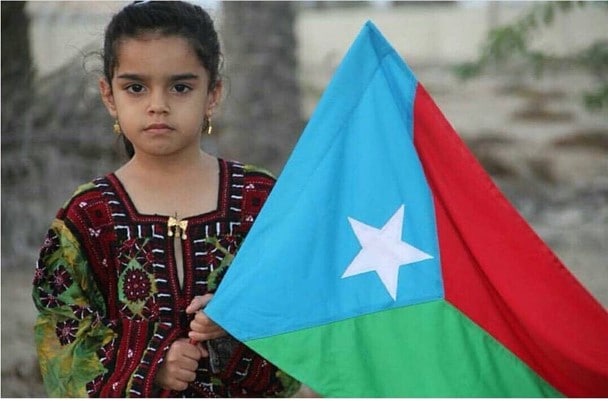
(Source: Twitter)
Molavi Abdolhamid Emerges As A Main Anti-Regime Leader
For decades, regardless of their political views and ideologies, Balochis have rallied around Molavi Abdolhamid Ismaeelzahi, the Sunni Imam of Zahedan, who has emerged as a charismatic leader with strong influence over Sunni Muslims across Iran, including Kurds.
Since the beginning of the uprising in Iran, Molavi Abdolhamid has strongly criticized the authorities for their brutality and for charging protesters with capital offenses. On December 2, 2022, the Sunni Imam said in a sermon that the Iranian regime should be held accountable for killing Sunni anti-regime protestors. He urged the regime to "sit down" with the protesters and reach a "middle ground," adding: "Where criticism is prevented, tyranny is created."
Molavi Abdolhamid said: "For 44 years, we have suffered from discrimination, inequality, and pressure. The entire Iranian people have suffered from discrimination... But now, the people are making demands. We are making demands. We, who are here, are also tired of the discrimination and the pressure. We are tired of poverty. Do not lock us up. Do not beat up the public. These people are hungry. Sit down with them and reach the middle ground... We have died. We have died here. Here we were killed with machine guns, for no reason... We were killed but we did not kill anyone, and we will not allow anyone to kill anyone else."[3]
In response to the regime's brutal crackdown on the Balochi people, Molavi Abdolhamid also called on Iranian authorities to hold a referendum on self-determination. On November 4, during a Friday sermon in the city of Zahedan, Molavi Abdolhamid said: "Hold a referendum with international observers. Officials, listen to the cry of the people. People have been [protesting] in the streets for 50 days now; you cannot push them back by killing and imprisoning them, because they have seen blood and they have had their own killed. Hold a referendum and see what the people of Iran want, and with what kind of change they will be happy."[4]
Molavi Abdolhamid's call came after Brigadier General Ahmad Shafaei, an Islamic Revolutionary Guards Corps (IRGC) commander based in Balochistan, said that Iran's enemies had targeted Zahedan as the first city to "fall" but that the elite force had foiled their efforts.[5] The comment came after, that the Islamic regime violently repressed the demonstrations of Balochi protesters on September 30, leading to what became known as the "Zahedan massacre," or "Bloody Friday," in which more than 90 people were killed.[6]
In response to Molavi Abdolhamid's call, Tasnim News Agency called the Sunni imam as a "source of insecurity" in Sistan and Baluchestan, stating that he should instead ask his " Saudi dictator friends to hold a referendum."[7] On November 28, 2022, London-based media outlet, Iran International, published leaked audio of Qasem Qoreyshi, deputy commander of the paramilitary Basij, revealing his concerns about the growing uprising in the country, and Molavi Abdolhamid's rising political power in Balochistan.[8]
In the audio, Qoreyshi stated that Supreme leader Ali Khamenei demanded that Molavi Abdolhamid must be warned. He then added: "We made a mistake about Abdolhamid. We first eliminated tribal leaders in the region to give more credit to Abdolhamid. However, he did not carry much weight [in the past]."[9]
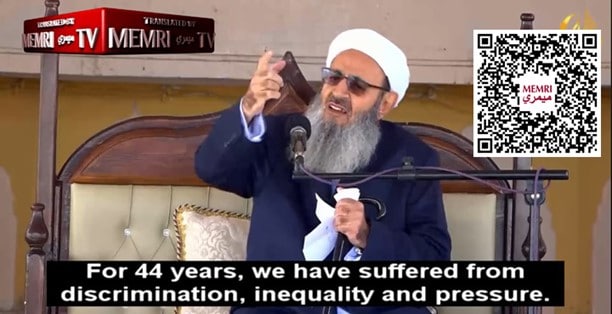
December 2, 2022 sermon in Zahedan by Maulvi Abdul Hamid. (Source: MEMRI TV clip No. 9978, In Zahedan, Iran Friday Sermon, Sunni Spiritual Leader Molavi Abdolhamid Demands Accountability For Victims Killed During Crackdown On Protesters, Adds: Where Criticism Is Prevented, Tyranny Is Created; Truth Must Always Be Followed, Even When Uttered By Americans And Israelis, December 2, 2022)
"Good Baloch – Bad Baloch"
For decades, Iranian and Pakistani governments have created a "good Baloch – bad Baloch" dichotomy. A "good Baloch" is one who accepts assimilation policies, and a "bad Baloch" is one who wants to preserve his identity and language. Consequently, Balochis fighting for basic human and ethnic rights have been described as unbelievers, terrorists, and mercenaries for foreign powers (i.e., the U.S., Saudi Arabia, and Israel),[10] while the pro-government Balochis, mostly mullahs and tribal leaders, have been described as noble and loyal.
However, the recent uprising against the regime united, even more, the Balochi people, who are fighting for the fall of the Islamic republic and for self-determination, after decades of living under repression. Women in Sistan and Balochistan have also been active in the ongoing uprising. Women in Zahedan have been seen holding "Woman, Life, Freedom" banners, and chanting anti-regime slogans, such as "Whether with hijab or without it, onward to the revolution."
It is worth noting that a recent report by Iran Human Rights (IHRNGO) shows that "Baluch prisoners accounted for 21 percent of all executions in 2021, although they only represent two to six percent of Iran's population."[11] It is also worth noting that, due to the lack of proper medical care, the rate of maternal and infant mortality in the Sistan and Baluchistan province is three times higher than the national average.[12] Further, the province has the lowest per capita income in Iran, with almost 80 percent of Balochis living below the national poverty line by some estimates, despite living in an area rich in natural resources.[13]
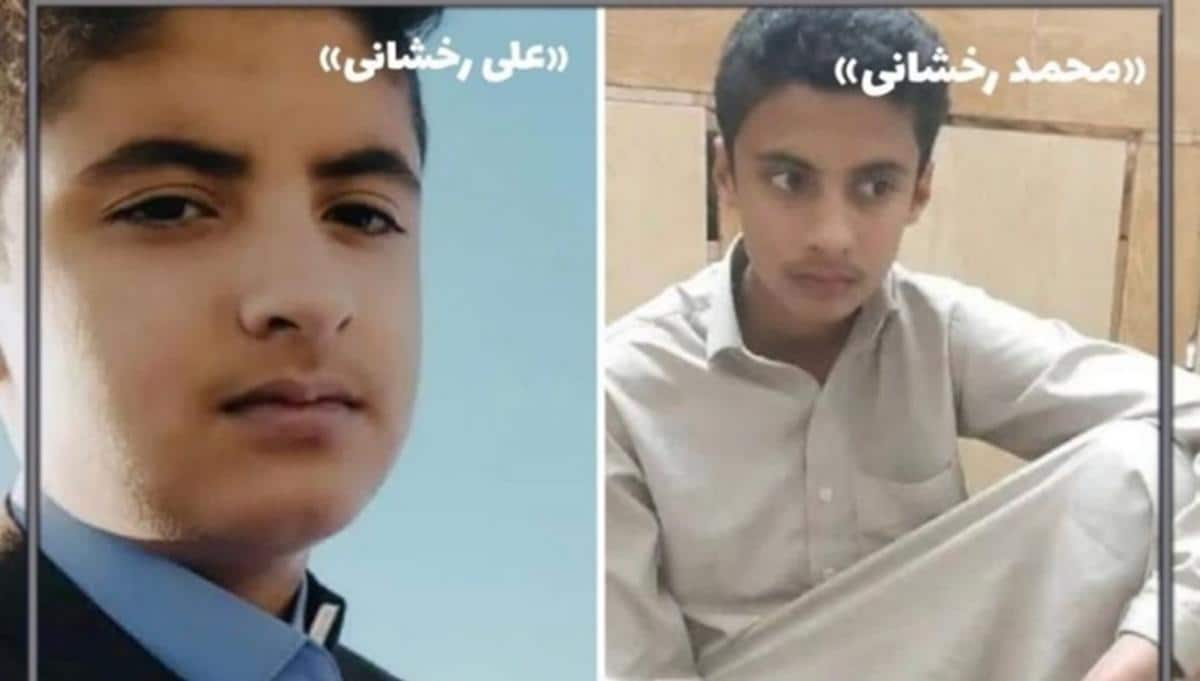
Ali Rakhshani, 16, and his brother Mohammad, 15, reportedly sentenced to death in Zahedan. (Source: Humgaam.net, December 3, 2022)
After the Iranian regime's September 30 massacre in Zahedan, the Iranian Minister of Interior Ahmad Vahidi justified further government brutality against Baluchis, saying: "We have witnessed a great deal of destruction by rioters and those who targeted the unity, stability, and comfort of Baluch and non-Baluch citizens, whose work is no less than what we expect from the enemy... The enemy targeted our unity, so we must show more than ever that the enemy's arrows did not hit its goals, and that we defend the strong Iran and its sovereignty, and that we will not allow the enemy to interfere in the affairs of the country." [14]
State-sponsored media outlet Iran In Arabic stated: "Takfiri and terrorist groups had spread out in the provinces of Kurdistan and Sistan and Balochistan, in western and eastern Iran, where they tried to separate the two provinces to turn them into two independent states."[15]
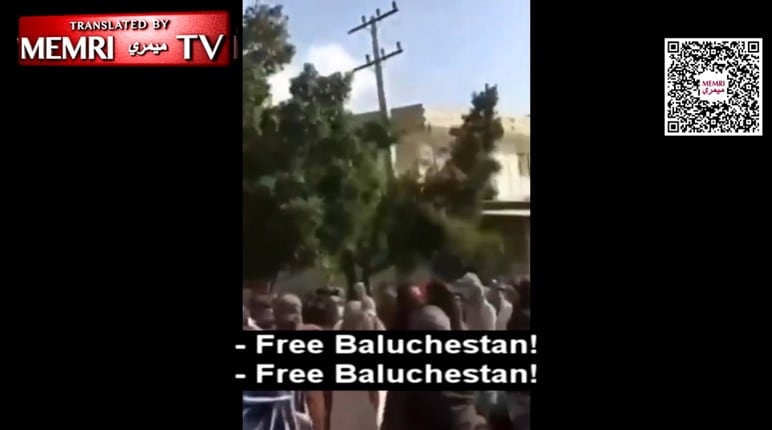
Anti-regime protests in Iran's Baluchestan province.
SUPPORT OUR WORK

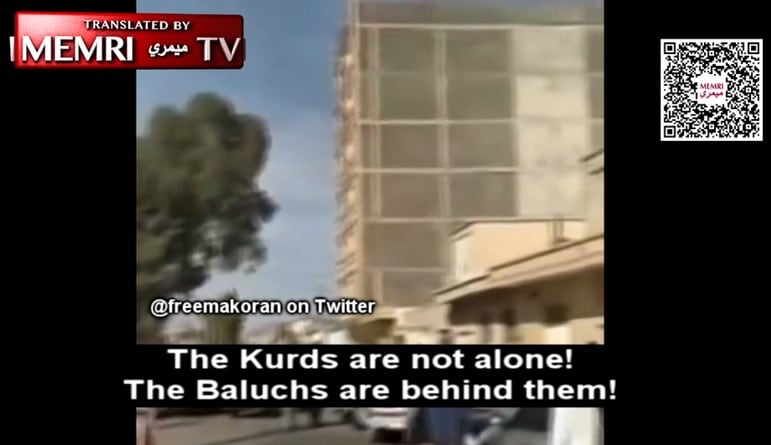
Anti-regime protests in Iran's Baluchestan province.
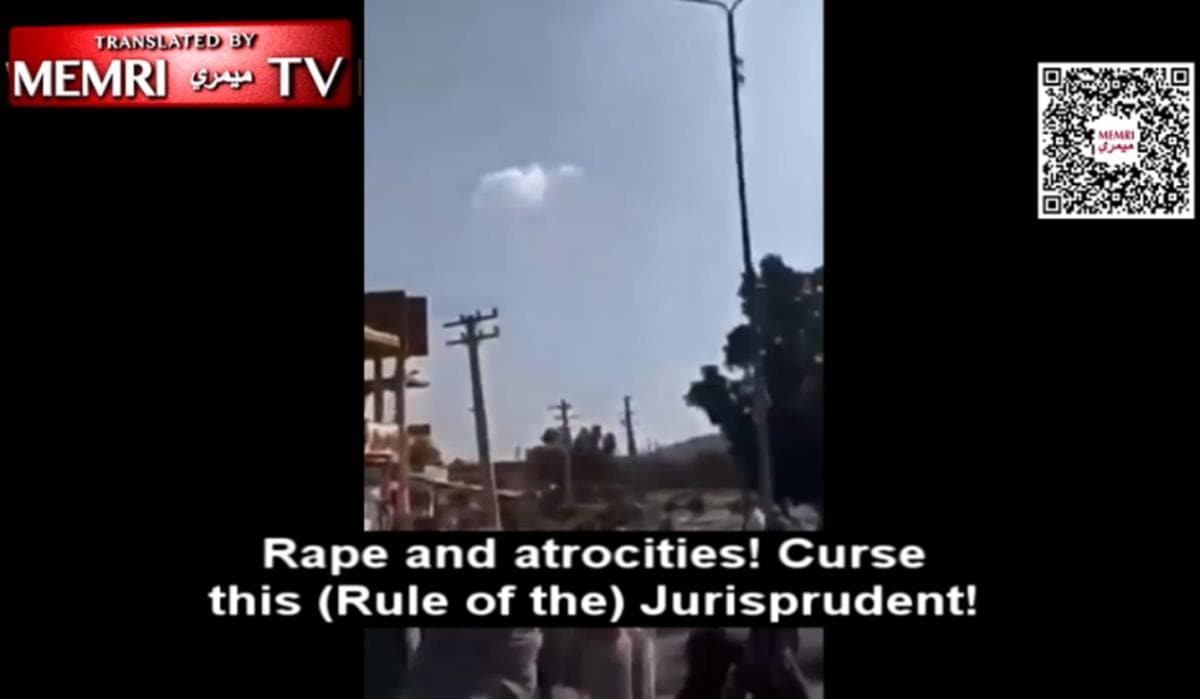
Anti-regime protests in Iran's Baluchestan province.
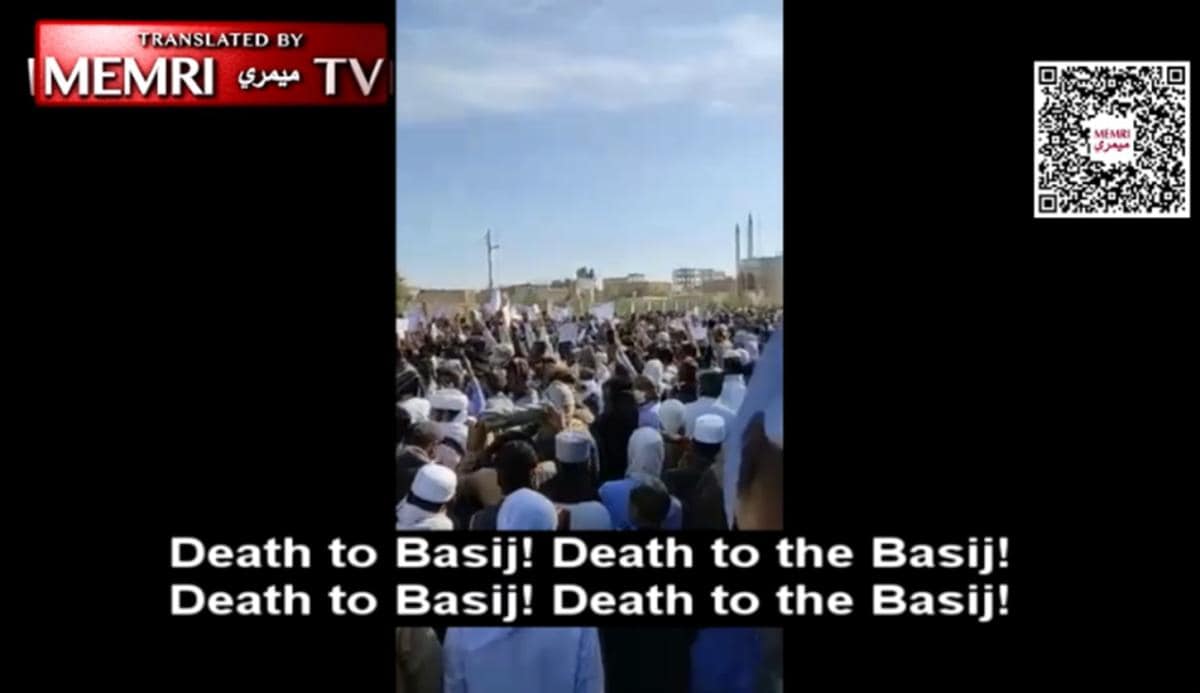
Anti-regime protests in Iran's Baluchestan province.
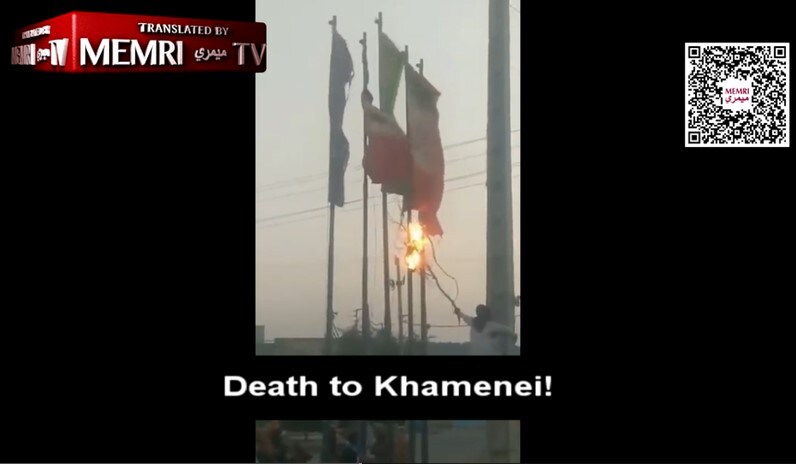
Anti-regime protests in Iran's Baluchestan province. (Source: MEMRI TV clip No. 9927, Anti-Regime Protests In Iran's Baluchestan Province: Free Baluchestan! The Kurds Are Not Alone! Curse The Rule Of The Jurisprudent! Death To Basiji!, November 11, 2022)
Khudanoor Lajai, A Symbol Of The Iranian Uprising
Khudanoor Lajai, a young Baloch killed by the Iranian regime, became one of the symbols of the Iranian uprising. Just after "Bloody Friday," Lajai was shot by the Iranian security forces. "The bullet hit him near the spinal cord, he was alive in the hospital, all we feared was that he was paralyzed, because his legs were numb. The doctors said that it was not necessary to operate on him... Zahedan Social Security Hospital falls under the branch of IRGC..." a source told Radio Zamaneh, stating that Lajai was left to die by hospital officials.[16]
Months earlier, Lajai was arrested, tortured, and handcuffed to a mast by the Basij. The viral photo of him with his hands tied to the flagpole was taken by Iranian security forces and given to his family. After his death, this photo inspired many anti-regime demonstrations, as Lajai became a symbol of the oppression endured by the Iran people.
Lajai, who had no birth certificate or identity papers, had an Instagram account to which he uploaded some videos of himself dancing in public, which is outlawed in Iran. Apparently, at the time he has been under arrest for quarreling with the son of a Basij, these videos were used to indict him. At the time, the local Baluchi community managed to free him, after collecting the sum of 100 million tomans (around $2,300) for his release.[17]

Khudanoor Lajai handcuffed to a mast (Source: Twitter)
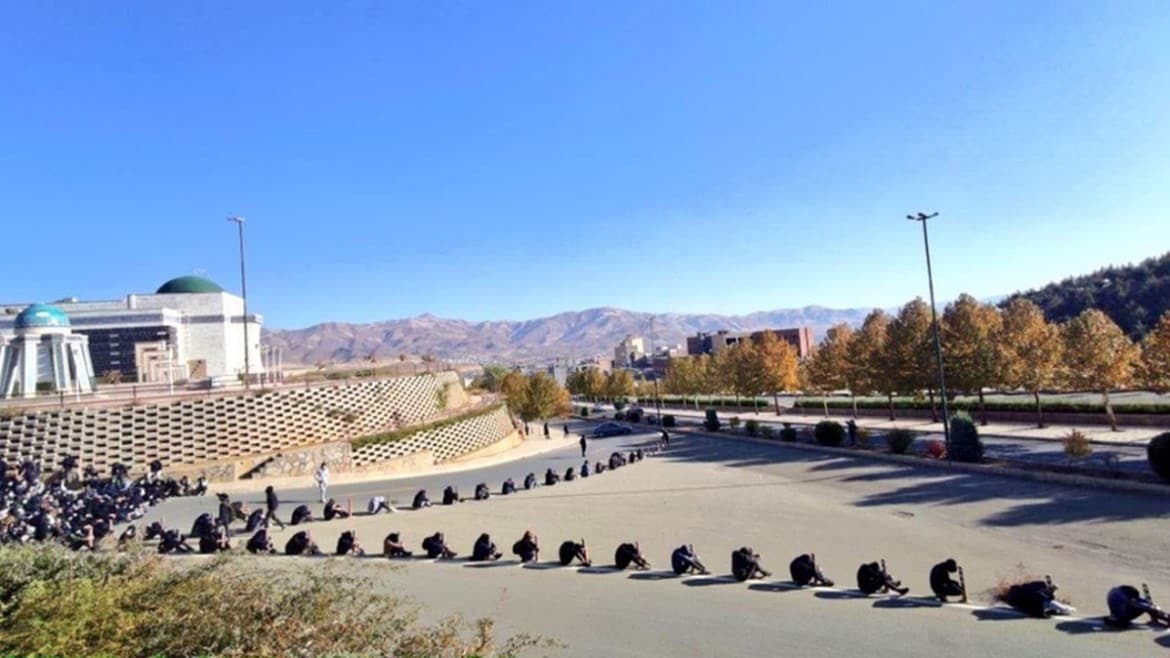
Anti-regime protest performance Kurdistan University students, in honor of Khodanur Lajai. (Source: Twitter)
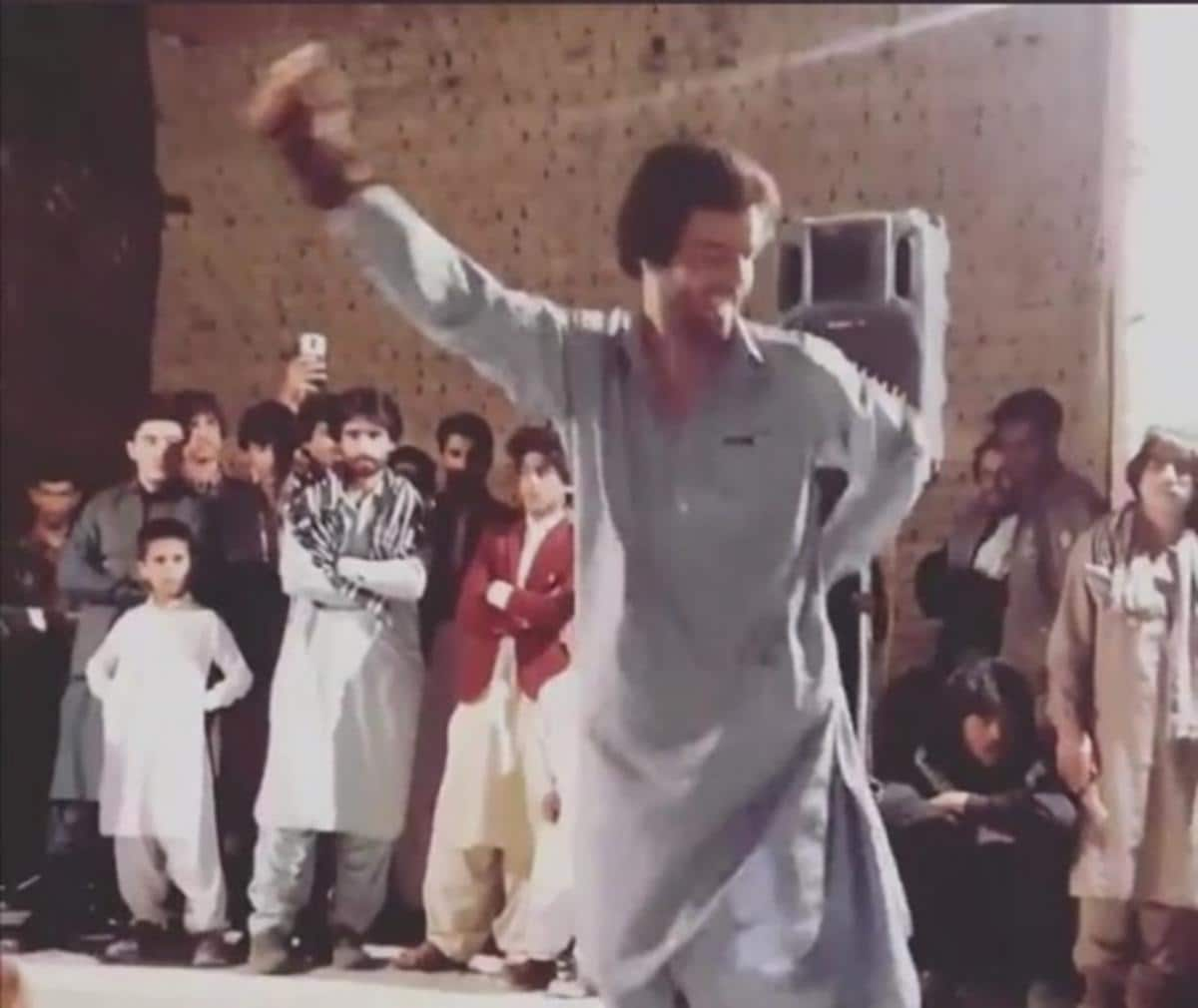
Khudanoor Lajai dancing (Source: Twitter)
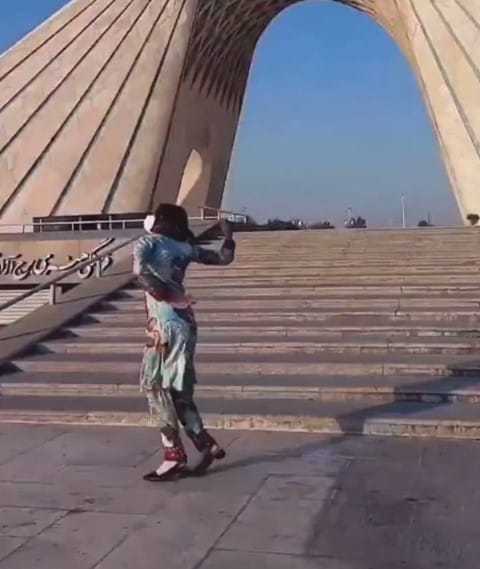
Defying shari'a, a woman dressed in traditional Baluch garment dances at foot of Tehran Azadi (Liberty) Tower to pay homage to Khodanour Lajai. (See video)
Iran-Pakistan Military Cooperation To Contain Balochi Nationalism
Meanwhile, security measures on the Iranian-Pakistani border have been tightened from both sides, due to concerns that the Balochis in Pakistan will militarily react to the repression of their co-ethnics in Sistan and Balochistan.
It appears that the Iranian regime drones have recently been deployed by Pakistan in its attacks on Baloch fighters. Azad Baloch, a spokesperson of the Baloch Liberation Army (BLA), said in a statement that nine Balochi fighters were killed in Balochistan's Kahan region in a drone strike by the Pakistan army on November 26. He directly accused Iran of supplying kamikaze drones to Pakistan. Iran and Pakistan have not yet rejected nor confirmed the allegation; however, recent bilateral agreements provide hints at the growing regional cooperation between the two countries with the sole objective of containing the growing Balochi nationalism.[18]
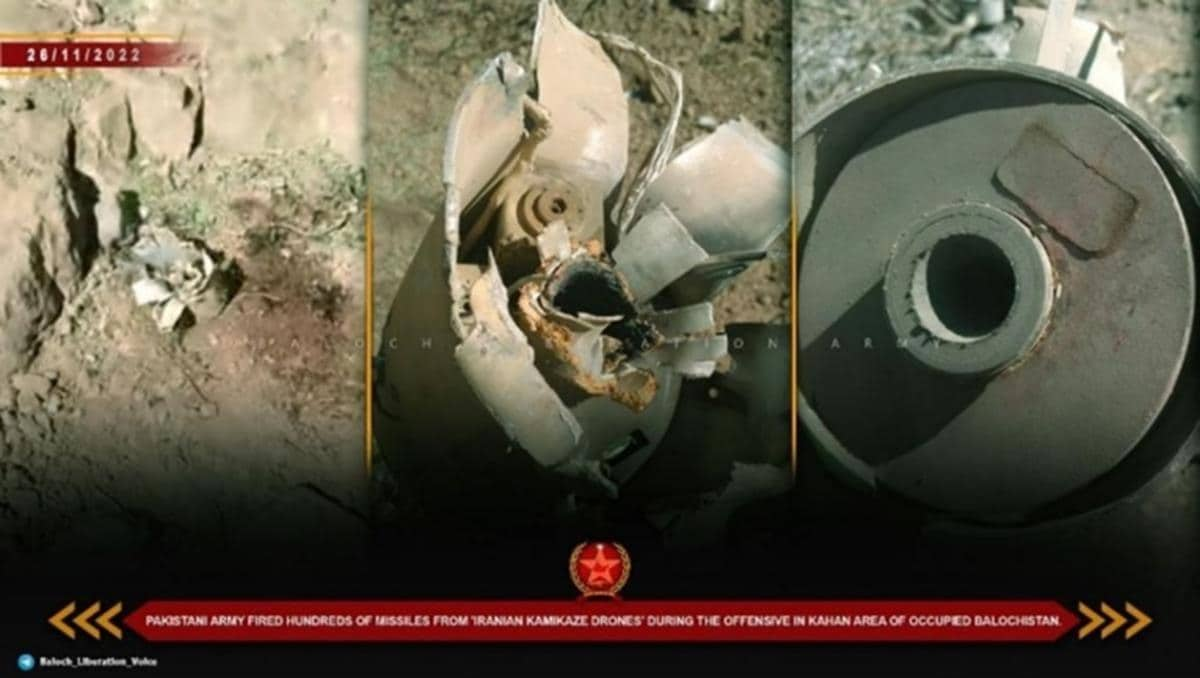
Iran-made suicide drone (Source: Baloch Liberation Voice)
Conclusion
The Iranian regime, along with the Pakistani one, is engaged in the "slow-motion genocide" of the Balochi people. In June 2022, the head of the Free Balochistan Movement, Hyrbyair Marri, stated that, from January to May 2022, 25 percent of the those executed by Iran were Balochis. He also added that executions of Baluchis on trumped-up charges are a way to "legitimize" and "legalize" "Balochocide," i.e., the century-long Iranian policy of genocide against the Baluchi people. Marri also said that, in the month of June, more than 120 Baloch prisoners were on death row awaiting execution in Zahedan Central Prison.[19]
According to Balochi websites and social media users, since the beginning of the protests, 77 Baloch prisoners have been executed.[20] The number can be even higher, as often security services do not inform families and do not even register the names of the executed prisoners. It is also worth noting that at the moment, two Balochi minors are expected to be executed soon. Ali Rakhshani, 16, and his brother Mohammad, 15, were reportedly sentenced to death in Zahedan.
It is time for the international community to act and put an end to the plight of minorities in Iran. On the day after "Bloody Friday" in Zahedan, Marri tweeted: " The murderous Iranian regime has truck again... This will forever be remembered as a black day. We, the Baloch, cannot rely on others to liberate us. Now is the time to unite against the occupiers."[21]
*Himdad Mustafa is a Kurdish scholar and expert on Kurdish and Iranian affairs.
[1] Iranprimer.usip.org/blog/2013/sep/03/iran-minorities-2-ethnic-diversity, September 3, 2013.
[2] See MEMRI Daily Brief No. 436, Balochistan Is A Strategic Outpost For Countering The Islamic Republic Of Iran, by Rudam Azad, December 6, 2022.
[3] See MEMRI Special Dispatch No. 10366, In Zahedan, Iran Friday Sermon, Sunni Spiritual Leader Molavi Abdolhamid Demands Accountability For Victims Killed During Crackdown On Protesters, Adds: Where Criticism Is Prevented, Tyranny Is Created; Truth Must Always Be Followed, Even When Uttered By Americans And Israelis, December 8, 2022; See MEMRI TV clip No. 9978, In Zahedan, Iran Friday Sermon, Sunni Spiritual Leader Molavi Abdolhamid Demands Accountability For Victims Killed During Crackdown On Protesters, Adds: Where Criticism Is Prevented, Tyranny Is Created; Truth Must Always Be Followed, Even When Uttered By Americans And Israelis, December 2, 2022.
[4] English.alarabiya.net/News/middle-east/2022/11/04/Iran-s-top-Sunni-cleric-calls-for-a-referendum-amid-anti-regime-protests, November 4, 2022.
[5] Ft.com/content/19ed45ec-2739-486d-999b-b7d9652722e6, November 6, 2022.
[6] See MEMRI Daily Brief No. 436, Balochistan Is A Strategic Outpost For Countering The Islamic Republic Of Iran, by Rudam Azad, December 6, 2022.
[7] Iranintl.com/en/202211051722, November 5, 2022.
[8] Iranintl.com/en/202211282012, November 28, 2022.
[9] Iranintl.com/en/202211282012, November 28, 2022.
[10] Presstv.ir/Detail/2022/11/14/692688/Leader-orders-probe-into-recent-incidents-southeast-Iran, November 14, 2022; Tasnimnews.com/en/news/2022/06/21/2732130/mossad-operatives-arrested-in-iran, June 21, 2022.
[11] Iranhr.net/media/files/Annual_Report_on_the_Death_Penalty_in_Iran_2021_BwW7LPR.pdf, 2021.
[12] Kayhanlife.com/society/infant-mortality-rate-alarmingly-high-in-sistan-and-baluchestan/, November 24, 2017.
[13] See MEMRI Daily Brief No. 436, Balochistan Is A Strategic Outpost For Countering The Islamic Republic Of Iran, by Rudam Azad, December 6, 2022.
[14] Tehrantimes.com/news/477351/Iran-president-orders-investigation-into-Zahedan-events, October 7, 2022.
[15] Iraninarabic.com/%D8%A8%D8%B9%D8%AF-%D8%AA%D9%88%D9%84%D9%8A%D9%87-%D9%85%D9%86%D8%B5%D8%A8%D9%87-%D8%A7%D9%84%D8%AC%D8%AF%D9%8A%D8%AF-%D8%A7%D9%84%D8%B3%D9%88%D8%AF%D8%A7%D9%86%D9%8A-%D9%8A%D8%B2%D9%88%D8%B1-%D8%B7/, November 29, 2022.
[16] Kurdistan-au-feminin.fr/2022/11/08/khodanur-lajai-lhistoire-dun-homo-sacer-baloutche-au-pays-des-mollahs-sanguinaires/, November 8, 2022.
[17] Kurdistan-au-feminin.fr/2022/11/08/khodanur-lajai-lhistoire-dun-homo-sacer-baloutche-au-pays-des-mollahs-sanguinaires/, November 8, 2022.
[18] Twitter.com/RudamAzad/status/1597556870431940610/photo/4, November 29, 2022.
[19] Balochwarna.com/2022/06/12/hyrbyair-marri-condemns-the-mass-executions-of-baloch-by-iran/, June 12, 2022.
[20] Twitter.com/sabermalekraisi/status/1602252102616711169, December 12, 2022.
[21] Twitter.com/hyrbyair_marri/status/1575956062611869696, October 1, 2022.


